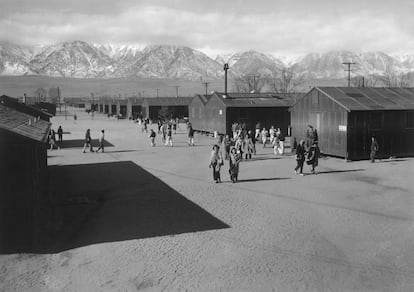Camp Manzanar serves as a reminder to the United States of racist laws in other eras
Organizations and experts warn of the danger of the Alien Enemies Act, which was used to justify the incarceration of 110,000 Japanese in World War Two and now, to deport migrants like Kilmar Abrego García


Camp Manzanar is located in a bucolic Californian landscape. From there, one can appreciate the imposing summit of the famous Mt. Whitney, one of the highest peaks in the United States. The area is attractive to those who enjoy mountain climbing, but the region is best known for having left behind an important historic lesson, after housing one of the internment camps that the Franklin D. Roosevelt administration created during World War II. A warning is written on a plaque visible to the site’s visitors: “May the injustices and humiliation suffered here as a result of hysteria, racism and economic exploitation never emerge again.”
The name of Manzanar has come up in recent weeks in Donald Trump’s America. It was the first of 10 internment camps that the United States set up after Japan’s attack on Pearl Harbor in December of 1941. Roosevelt, who was president at the time, released a series of decrees directed toward people living in the United States who had heritage from or other links to the Axis countries. Washington feared that these residents had sworn loyalty to Germany, Italy or Japan and that it would help them during combat on U.S. territory.
Roosevelt created the series of camps (except for two) through an executive order: 9066, which was signed into effect in February 1942. The order is today a shameful stain on the country’s history, and paved the way to the detention — authorities at the time called them “evacuations” — and incarceration in Manzanar of 110,000 Japanese individuals. Some were immigrants, but it’s been calculated that two-thirds of those detained were born in the country and had U.S. citizenship. The camps also served to imprison 11,500 Germans and around 3,000 Italians.
The legal basis employed at the time was the Alien Enemies Act, a law passed in 1798 that had only been used on a few occasions, all during times of war. The first was in 1812, during a conflict with the United Kingdom. It was revived in the 20th century, initially during World War I and then after the bombing of Pearl Harbor. U.S. authorities began making arrests just 11 days after the attack on the naval base in Hawaii.

It’s the same law that Trump has dusted off as a tool in his fight against what he considers to be another invasion, that of undocumented immigrants. “The Trump administration has set new precedent in the use of conflict-related powers and further expanded the executive branch’s latitude to monitor, detain, and deport noncitizens,” the Migration Policy Institute, a Washington D.C. think tank, declared in a statement.
The Republican president has invoked the law in order to facilitate the detention for deportation of citizens of Venezuela and El Salvador, as demonstrated by the case of Kilmar Abrego García. The 29-year-old was arrested in March, accused of belonging to a gang, and sent to his native El Salvador, specifically to President Nayib Bukele’s maximum-security prison. This, despite the fact that he had already established “well-founded fear,” meaning that he’d proven to migrant authorities that his life would be in danger if he returned to his country.
Abrego García’s deportation has caused a clash between different arms of the government. The Supreme Court ordered the Trump administration to facilitate the citizen’s return, with which the executive branch has refused to comply, arguing that he is now out of its jurisdiction. On Wednesday, White House spokesperson Karoline Leavitt said that if he returned to the country, Abrego García would be deported again.
James Boasber, the district judge who determined that Abrego García’s deportation was illegal, said on Wednesday that he would initiate contempt proceedings against the executive branch. Stephen Miller, Trump’s influential public policy adviser and the mastermind behind the use of the Alien Enemies Act as a weapon to control immigration, has lashed out at the judge, arguing that the law is virtually unassailable.
“The Alien Enemies Act, which was passed into law by the founding generation of this country — men like John Adams — was written explicitly to give the President the authority to repel an alien invasion of the United States. That is not something that a district court judge has any authority whatsoever to interfere with, enjoin, restrict, or restrain in any way. You can read the law yourself; there’s not one clause in that law that makes it subject to judicial review,” Miller asserted at the end of March, when the showdown began between the courts and the White House.

Amid this dispute, the shadow of the internment camps, which operated through 1947 and where day-to-day life was captured by photographers such as Ansel Adams, looms large. Densho, a nonprofit organization that preserves the history of Japanese Americans who were interned, was one of the first to call attention to the parallels. “If this history teaches us anything, it should be the devastating consequences of allowing fear and xenophobia to shape our national policies, and the importance of resisting the resurgence of laws like the Alien Enemies Act,” wrote the association in October, when Trump first promised to wield the law during one of his rallies.
Densho also offered a reminder that during the Second World War, the law led to the creation of a hundred special courts, which decided if detainees would go to an internment camp or receive conditional freedom. Herbert Nicholson, a missionary who worked at the time as a translator, called this process a “farce” that did not allow those accused legal representation nor to dispute the alleged evidence, which was mostly hearsay testimony. Judging by court records, it is precisely this kind of evidence that today has Abrego García locked in a prison thousands of miles from his family.
Sign up for our weekly newsletter to get more English-language news coverage from EL PAÍS USA Edition
Tu suscripción se está usando en otro dispositivo
¿Quieres añadir otro usuario a tu suscripción?
Si continúas leyendo en este dispositivo, no se podrá leer en el otro.
FlechaTu suscripción se está usando en otro dispositivo y solo puedes acceder a EL PAÍS desde un dispositivo a la vez.
Si quieres compartir tu cuenta, cambia tu suscripción a la modalidad Premium, así podrás añadir otro usuario. Cada uno accederá con su propia cuenta de email, lo que os permitirá personalizar vuestra experiencia en EL PAÍS.
¿Tienes una suscripción de empresa? Accede aquí para contratar más cuentas.
En el caso de no saber quién está usando tu cuenta, te recomendamos cambiar tu contraseña aquí.
Si decides continuar compartiendo tu cuenta, este mensaje se mostrará en tu dispositivo y en el de la otra persona que está usando tu cuenta de forma indefinida, afectando a tu experiencia de lectura. Puedes consultar aquí los términos y condiciones de la suscripción digital.
More information
Archived In
Últimas noticias
ICE raids trigger school absenteeism and traumatize children: ‘They have been forced to leave their childhood behind’
The guardians of the meteorites of the Argentine Chaco
Helen Levitt, the photographer who captured the theater of the everyday
Maude Apatow, from acting in ‘Euphoria’ to directing: ‘There are many films that you can tell weren’t written by someone young’
Most viewed
- Christian Louboutin: ‘Young people don’t want to be like their parents. And if their parents wear sneakers, they’re going to look for something else’
- The low-cost creative revolution: How technology is making art accessible to everyone
- US sanctions against jailed cartel leader ‘El Marro’ highlight Mexico’s lack of control over its prisons
- Liset Menéndez de la Prida, neuroscientist: ‘It’s not normal to constantly seek pleasure; it’s important to be bored, to be calm’
- Cartels in Mexico take a leap forward with narco-drones: ‘It is criminal groups that are leading the innovation race’










































